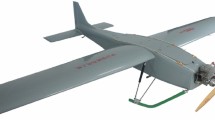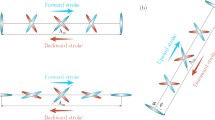Abstract
Within the growing family of unmanned aerial vehicles (UAV), flapping-wing micro aerial vehicles (MAV) are a relatively new field of research. Inspired by small size and agile flight of insects and birds, these systems offer a great potential for applications such as reconnaissance, surveillance, search and rescue, mapping, etc. Nevertheless, practicality of these vehicles depends on how we address various challenges ranging from control methodology to morphological construction and power supply design. A reasonable approach to resolving such problems is to acquire further inspiration from solutions in nature. Through modeling synchronous muscles in insects, we have shown that manipulation of mechanical impedance properties at wing joints can be a very efficient method for controlling lift and thrust production in flapping-wing MAVs. In the present work, we describe how this approach can be used to decouple lift/thrust regulation, thus reducing the complexity of flight controller. Although of simple design, this controller is still capable of demonstrating a high degree of precision and maneuverability throughout various simulated flight experiments with different types of trajectories. Furthermore, we use these flight simulations to investigate the power requirements of our control approach. The results indicate that these characteristics are considerably lower compared to when conventional control strategies—methods that often rely on manipulating stroke properties such as frequency or magnitude of the flapping motion—are employed. With less power demands, we believe our proposed control strategy is able to significantly improve flight time in future flapping-wing MAVs.
Similar content being viewed by others
References
Cook, K.L.B.: The silent force multiplier: the history and role of UAVs in warfare. In: 2007 IEEE Aerospace Conf., Big Sky, MT, USA, 3–10 March 2007
Osborne, M.F.M.: Aerodynamics of flapping flight with application to insects. J. Exp. Biol. 28(2), 221–245 (1951)
Ellington, C.P.: The aerodynamic of hovering insect flight I. The quasi-steady analysis. Philos. Trans. R. Soc. Lond. B Biol. Sci. 305(1122), 1–15 (1984)
Dickinson, M.H., Lehmann, F., Sane, S.P.: Wing rotation and the aerodynamic basis of insect flight. Science 284(5422), 1954–1960 (1999)
Floreano, D., Zufferey, J.C., Srinivasa, M.V., Ellington, C.P.: Flying Insects and Robots, Springer (2010)
Cheng, B., Deng, X.: Near-hover dynamics and altitude stabilization of an insect model. In: 2010 American Control Conf. (ACC), Baltimore, MD, USA, 30 June–2 July 2010
Sane, S.P.: Steady or unsteady? Uncovering the aerodynamic mechanisms of insect flight. J. Exp. Biol. 214, 349–351 (2011)
Whitney, J.P.: Design and Performance of Insect-Scale Flapping-Wing Vehicles (PhD Dissertation). Harvard University, USA (2012)
Wood, R.J.: The first takeoff of a biologically inspired at-scale robotic insect. IEEE Trans. Robot. 24, 341–347 (2008)
de Croon, G.C.H.E., de Clerq, K.M.E., Ruijsink, R., Remes, B., de Wagter, C.: Design, aerodynamics, and vision-based control of the DelFly. Int. J. Micro Air Vehicles. 1(2), 71–97 (2009)
Michelson, R., Helmick, D., Reece, S., Amarena, C.: A reciprocating chemical muscle (RCM) for micro air vehicle ‘Entomopter’ flight. In: The Association for Unmanned Vehicle Systems International (AUVSI), Baltimore, MD, USA, 3–6 June 1997
Hsiao, F.Y., Chen, C.L., Shen, J.F.: Altitude control of flapping-wing MAV using vision-based navigation. In: 2010 American Control Conf. (ACC), Baltimore, MD, USA, 30 June–2 July 2010
Perez-Arancibia, N.O., Barrows, G.L., Wood, R.J.: Altitude feedback control of a flapping-wing microrobot using an on-board biologically inspired optical flow sensor. In: 2012 IEEE Int. Conf. Robotics and Automation (ICRA), St Paul, MN, USA, 14–18 May 2012
Malhan, R., Benedict, M., Chopra, I.: Experimental studies to understand the hover and forward flight performance of a MAV-scale flapping wing concept. J. Am. Helicopter Soc. 57, 1–11 (2012)
Doman, D.B., Oppenheimer, M.W., Sigthorsson, D.O.: Wingbeat shape modulation for flapping-wing micro-air-vehicle control during hover. J. Guid. Control Dyn. 33(3), 724–739 (2010)
Jones, E., Vachtsevanos, G.: Fixed frequency, variable amplitude (FiFVA) actuation systems for micro aerial vehicles. In: 2011 IEEE Int. Conf. Robotics and Automation (ICRA), Shanghai, China, 9–13 May 2011
Perez-Arancibia, N.O., Whitney, J.P., Wood, R.J.: Lift force control of flapping-wing microrobots using adaptive feedforward schemes. IEEE Trans. Mechatron. 18(1), 155–168 (2013)
Doman, D.B., Oppenheimer, M.W.: Dynamics and control of a minimally actuated biomimetic vehicle: part II. Control. In: AIAA Guidance, Navigation, and Control Conf. Chicago, IL, USA, 10–13 August 2009
Deng, X., Schenato, L., Wu, W.C., Sastry, S.S.: Flapping flight for biomimetic robotic insects: part I–system modeling. IEEE Trans. Robot. 22(4), 776–788 (2006)
Mahjoubi, H., Byl, K.: Tunable impedance: a semi-passive approach to practical motion control of insect-inspired MAVs. In: 2012 IEEE Int. Conf. Robotics and Automation (ICRA), St Paul, MN, USA, 14–18 May 2012
Dudley, R.: The Biomechanics of Insect Flight: Form, Function, Evolution. Princeton University Press, USA (2000)
Mahjoubi, H., Byl, K.: Insect flight muscles: inspirations for motion control in flapping-wing MAVs. In: 2012 Int. Conf. Unmanned Aircraft Systems (ICUAS), Philadelphia, PA, USA, 12–15 June 2012
Mahjoubi, H., Byl, K.: Modeling synchronous muscle function in insect flight: a bio-inspired approach to force control in flapping-wing MAVs. J. Int. Robot. Syst. 70(1–4), 181–202 (2013)
Bergou, A.J., Xu, S., Wang, Z.J.: Passive wing pitch reversal in insect flight. J. Fluid Mech. 591, 321–337 (2007)
Mahjoubi, H., Byl, K.: Analysis of a tunable impedance method for practical control of insect-inspired flapping-wing MAVs. In: 2011 IEEE Conf. on Decision and Control and European Control Conference (CDC-ECC), Orlando, FL, USA, 12–15 December 2011
Mahjoubi, H., Byl, K.: Steering and horizontal motion control in insect-inspired flapping-wing MAVs: the tunable impedance approach. In: 2012 American Control Conf. (ACC), Montreal, QC, Canada, 27–29 June 2012
Unknown Author: Insect Wings. Amateur Entomologists’ Society Webpage. http://www.amentsoc.org/insects/fact-files/wings.html (2013). Accessed 27 Sept 2013
Schultz, A.B., Faulkner, J.A., Kadhiresan, V.A.: A simple hill element-nonlinear spring model of muscle contraction biomechanics. J. Appl. Physiol. 70(2), 803–812 (1991)
Dickinson, M.H.: The effects of wing rotation on unsteady aerodynamic performance at low Reynolds numbers. J. Exp. Biol. 192, 179–206 (1994)
Willmott, A., Ellington, C., van den Berg, C., Thomas, A.: Flow visualization and unsteady aerodynamics in the flight of the hawkmoth Manduca sexta. Philos. Trans. R. Soc. Lond. B Biol. Sci. 352, 303–316 (1997)
Sane, S.P.: The aerodynamics of insect flight. J. Exp. Biol. 206, 4191–4208 (2003)
Fung, Y.C.: An Introduction to the Theory of Aeroelasticity. Dover Publications, Inc. NY, USA (1969)
Sane, S.P., Dickinson, M.H.: The control of flight by a flapping wing: lift and drag production. J. Exp. Biol. 204, 2607–2626 (2001)
Dickson, W.B., Dickinson, M.H.: The effect of advance ratio on the aerodynamics of revolving wings. J. Exp. Biol. 204(207), 4269–4281 (2004)
McKelvey, T., Akcay, H., Ljung, L.: Subspace-based multivariable system identification from frequency response data. IEEE Trans. Autom. Control. 41(7), 960–979 (1996)
Hedrick, T.L., Cheng, B., Deng, X.: Wingbeat time and the scaling of passive rotational damping in flapping flight. Science 324(5924), 252–255 (2009)
Mahjoubi, H., Byl, K.: Trajectory tracking in sagittal plane: decoupled lift/thrust control via tunable impedance approach in flapping-wing MAVs. In: 2013 American Control Conf. (ACC), Washington, DC, USA, 17–19 June 2013
Wolf, L.L., Hainsworth, F.R.: Time and energy budgets of territorial hummingbirds. Ecol. 52(6), 980–988 (1971)
Pearson, O.P.: The daily energy requirements of a wild Anna hummingbird. The Condor 56(6), 317–322 (1954)
Gill, F.B.: Hummingbird flight speeds. The Auk 102(1), 97–101 (1985)
Author information
Authors and Affiliations
Corresponding author
Rights and permissions
About this article
Cite this article
Mahjoubi, H., Byl, K. Efficient Flight Control via Mechanical Impedance Manipulation: Energy Analyses for Hummingbird-Inspired MAVs. J Intell Robot Syst 73, 487–512 (2014). https://doi.org/10.1007/s10846-013-9928-1
Received:
Accepted:
Published:
Issue Date:
DOI: https://doi.org/10.1007/s10846-013-9928-1




